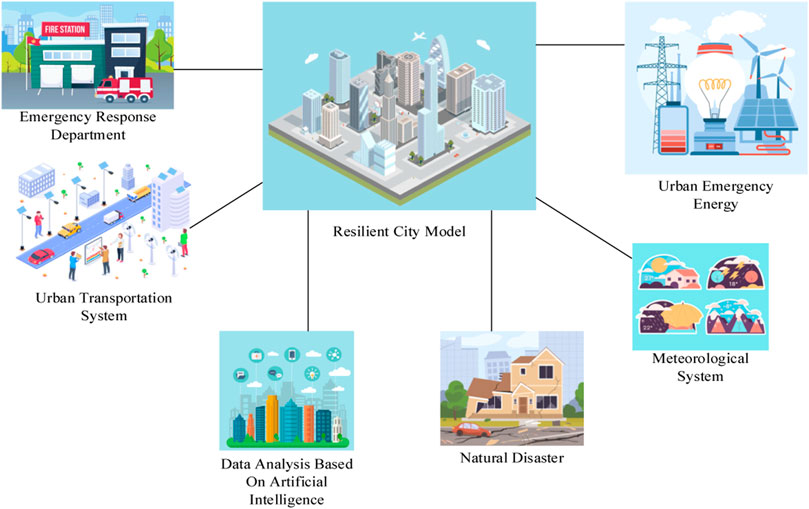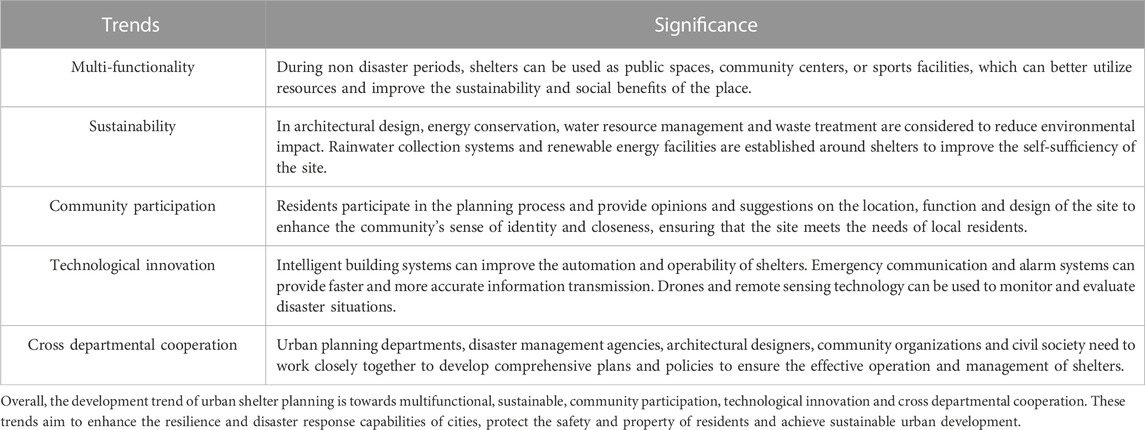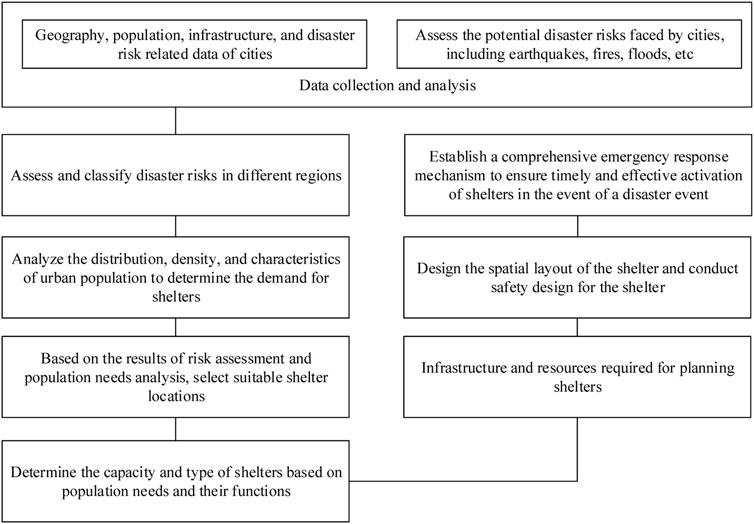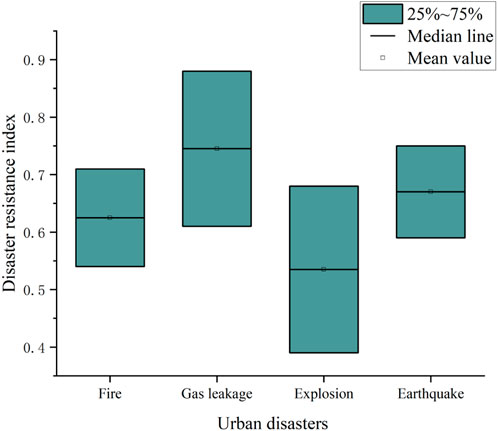- 1School of Civil Engineering and Architecture, Northeast Petroleum University, Daqing, Heilongjiang, China
- 2Daqing Institute of Planning and Architecture, Daqing, Heilongjiang, China
Cities based on oil and gas energy resources are crucial to energy production and economic development, but they also face various disasters and security risks. To ensure the safety and well-being of urban residents during disaster events, the planning of urban shelters is crucial. In this paper, comprehensively considering multiple factors such as disaster risk, population distribution, and convenient transportation, the artificial bee colony algorithm is used to optimize the site selection and capacity planning of shelters. By comprehensively evaluating the disaster resistance capacity of urban refuges, the response speed of residents and other related indicators, the planning algorithm of refuges is continuously optimized to better meet the needs of oil and gas energy resource-based cities. The results of the study showed that the average overall disaster resilience of AI-based urban shelters reached 0.64. When the distance to the shelter was 4 km, the average response speed of residents reached 10.22 min, and other indicators also improved. The research shows that the oil and gas energy urban refuge planning algorithm based on the artificial intelligence elastic city model provides an innovative approach for urban planners and disaster managers. Further research and practice will help promote the application of this algorithm in real cities, improving the resilience and disaster resistance of cities and the safety and security level of residents.
1 Introduction
In recent years, oil and gas energy resource-based cities have faced an increasing number of disasters and emergency threats, such as fires, gas leaks and earthquakes. These disasters not only pose risks to the life safety of urban residents, but may also cause huge economic losses and environmental damage. When facing these challenges, it is crucial to plan and layout shelters for oil and gas energy resource-based cities in a reasonable manner. However, traditional shelter planning methods often lack flexibility and comprehensiveness, and are unable to cope with complex and ever-changing disaster scenarios and urban characteristics. Therefore, this article discusses a planning algorithm for shelters in oil and gas resource-based cities based on the artificial intelligence resilient city model. This algorithm combines the concepts of artificial intelligence and resilient cities, aiming to improve the resilience and adaptability of shelters through intelligent decision-making and optimization methods to cope with different types of disasters and emergencies.
The development of artificial intelligence has promoted progress in many fields and to some extent improved people’s lives. Zhuomin Sun believed that artificial intelligence education was defined as the utilization of artificial intelligence in the field of education. By developing a deep learning assisted online intelligent English teaching system and creating a modern tool platform, students could improve their English teaching efficiency and match it with their mastery of knowledge and personality (Sun et al., 2021). Benjamin H. Kann considered that artificial intelligence could integrate and integrate data collected from clinical oncology, infer patterns and predict results to improve shared patient and clinical physician decision-making (Kann et al., 2021). Anirbid Sircar reckoned that the oil and gas industry faced some challenges and problems in data processing and machine learning and artificial intelligence could solve problems in the oil and gas industry (Sircar et al., 2021). Imran Ahmed proposed that artificial intelligence could be considered a major component of industrial transformation, enabling intelligent machines to autonomously perform tasks such as self-monitoring, interpretation, diagnosis and analysis. Artificial intelligence based methods, especially machine learning and deep learning, supported manufacturers and industries in predicting their maintenance needs and reducing downtime (Ahmed et al., 2022). Bo Zhang thought that it was necessary to establish a new interpretable and robust artificial intelligence theory to develop safe, reliable and scalable new artificial intelligence technologies (Zhang et al., 2023). Araz Taeihagh considered that the new applications of artificial intelligence provided opportunities to improve economic efficiency and quality of life, but they also had unexpected consequences. To minimize adverse risks, governments around the world needed to better understand the scope and depth of the risks posed and developed regulatory and governance processes and structures to address these challenges (Taeihagh, 2021). These scholars’ research on artificial intelligence involves fields such as education, healthcare and industry, but does not involve the planning of urban shelters.
The construction of cities has promoted social development, but the gathering of a large population also brings hidden dangers. The establishment of shelters can ensure the safety of urban residents. Jia Yu believed that timely and safe evacuation of residents to nearby urban emergency shelters was crucial in unexpected disaster events. However, evacuation and allocation of shelters were rarely reviewed as a whole and there were certain issues with the spatial allocation of shelters. Optimizing the spatial allocation of shelters might help local residents evacuate faster and safer (Jia et al., 2018). Javad Junian considered that earthquakes were notorious destructive natural disasters that could lead to tragic deaths and economic losses. Building earthquake shelters was an effective way to reduce earthquake consequences and protect lives (Junian and Azizifar, 2018). A. Kimms reckoned that the purpose of urban evacuation plans was to minimize overall danger under various restrictions, such as rescuing all evacuees, but was affected by many uncertainties. He also proposed a special path algorithm that could generate evacuation paths according to special requirements (Kimms and Maiwald, 2018). Wei Xu thought that accurate positioning and allocation of disaster emergency shelters were key components of effective urban planning and emergency management (Xu et al., 2018). These scholars’ research has promoted the development of shelters, but there is a lack of integration with artificial intelligence.
The goal of this article is to optimize the location, capacity planning and facility configuration of oil and gas energy resource-based urban shelters through artificial bee colony algorithm. Meanwhile, taking into account the requirements of spatial layout and safety design, the disaster resistance ability of shelters and the safety of residents are ameliorated. Through the application of this algorithm, it is expected to provide an innovative method for the planning of shelters in oil and gas energy resource-based cities, improve the resilience and response capacity of cities and ensure the safety and wellbeing of residents in disasters and emergencies. This article introduces the key ideas, methods and implementation steps of the proposed algorithm for planning shelters in oil and gas energy resource-based cities based on the artificial intelligence resilient city model, evaluating the performance and effectiveness of the algorithm through experimental verification. Finally, the advantages and application prospects of this algorithm are discussed and possible improvements and future research directions are proposed. Through the research in this article, it is expected to provide practical and effective decision-making support for the planning of shelters in oil and gas energy resource-based cities and make positive contributions to urban disaster management and social security.
2 Overview of resilient city models
2.1 Resilient city model
The resilient city model is a concept of urban planning and management aimed at improving the adaptability and resilience of cities in the face of various pressures and impacts. These pressures and impacts may include natural disasters (such as earthquakes, floods and hurricanes), climate change, human accidents (such as terrorist attacks and industrial accidents) and socio-economic changes. The resilient city model emphasizes the sustainability and resilience of a city to ensure that it can maintain its function and operation in the face of pressure and can quickly return to normal state (Meerow et al., 2019; Sara and Joshua, 2019).
This model involves multiple aspects of planning and management, including the following key elements: multi-functional infrastructure: The resilient city model advocates the construction of multi-functional infrastructure, which can not only meet daily needs but also perform other functions in emergency situations. For example, a building can be used as an office building or a school, but it can also serve as a shelter in the event of a disaster; multi source energy supply: The resilient city model encourages cities to adopt multi source energy supply to reduce dependence on a single energy source. This includes utilizing renewable energy and energy reserve systems to ensure that cities can maintain operations in the event of energy supply disruptions; community participation and cooperation: The resilient city model emphasizes community participation and cooperation, encouraging residents to participate in urban planning and decision-making processes. This can enhance the cohesion and unity of the community, making the community work together to respond and recover in the face of crises; data-driven decision-making: The resilient city model advocates the use of data and information technology to support decision-making. By collecting, analyzing and utilizing urban data, it is possible to better understand the vulnerability and potential risks of cities and take corresponding measures to enhance their resilience (Moreno et al., 2021); disaster risk management: The resilient city model emphasizes the importance of disaster risk management in disaster risk management. This includes measures such as conducting risk assessments, establishing emergency response mechanisms, improving disaster warning systems and strengthening the seismic capacity of buildings and infrastructure to reduce losses caused by disasters.
The resilient city model is a comprehensive concept aimed at establishing sustainable, resilient and adaptable cities. By comprehensively considering factors such as urban planning, infrastructure construction, community participation and disaster management, the resilient city model can enhance the city’s response capacity, reduce risks and improve the quality of life of residents.
2.2 Artificial intelligence resilient city model
Artificial intelligence plays an important role in resilient city models. Artificial intelligence technology can provide support for urban planning, management and disaster response, improving the resilience and adaptability of cities. The application of artificial intelligence in resilient city models includes data analysis and prediction. Artificial intelligence can analyze large-scale urban data, including meteorological data, traffic data, population data, etc., to predict potential disasters and risks. Through machine learning and data mining techniques, potential threats faced by cities can be identified. Preventive and disaster reduction measures can be taken in advance. For smart energy management, artificial intelligence can be used for urban energy management to improve energy efficiency and sustainability by optimizing energy allocation and consumption. Technologies such as smart grid management, energy demand forecasting and distributed energy systems can provide flexibility and resilience to respond to changes in energy supply and emergencies. With the most important aspect of intelligent disaster management, artificial intelligence can play a crucial role in disaster management. Through intelligent sensor networks and data analysis, natural disasters such as earthquakes, floods and storms can be monitored and warned in real-time. Technologies such as intelligent emergency response systems and intelligent rescue robots can improve the efficiency and accuracy of disaster response. In urban planning and design, artificial intelligence can support the process of urban planning and design, providing multiple solutions and decision support through simulation and optimization algorithms. Intelligent city modeling can evaluate the resilience and feasibility of urban planning schemes, helping decision-makers make better decisions. The artificial intelligence resilient city model is shown in Figure 1.
The use of artificial intelligence in resilient city models can help improve the responsiveness of cities, reduce risks and improve the quality of life of residents. However, attention also needs to be paid to the ethical and privacy issues of artificial intelligence to ensure that the technology is used ethically and legally.
3 Theoretical basis and development of urban shelter planning
3.1 Theoretical basis for urban shelter planning
The purpose of urban shelter planning is to ensure the life safety and wellbeing of urban residents in the event of a disaster, emergency or other dangerous event. Therefore, the theoretical basis of urban shelter planning mainly involves: disaster management theory, spatial planning theory, sociological and psychological theory, engineering and architectural theory, as shown in Table 1.
In summary, the theoretical foundation of urban shelter planning encompasses theoretical knowledge from multiple disciplines such as disaster management, spatial planning, sociology and psychology, engineering and architecture. These theories provide guidance for planners to develop appropriate shelter planning strategies to respond to various disasters and emergencies faced by cities.
3.2 Development of urban shelter planning
The development of urban shelter planning is one of the important issues in the fields of disaster management and urban planning. With the impact of factors such as climate change, frequent natural disasters and population growth, the planning of urban shelters is receiving increasing attention. The planning of urban shelters is developing towards multi-functionality, sustainability, community participation, technological innovation and cross departmental cooperation, as shown in Table 2.
4 Planning of shelters in oil and gas energy resource-based cities
4.1 Planning concept of shelters in oil and gas energy resource-based cities
In the planning of shelters in oil and gas energy resource-based cities, many factors need to be considered. The primary principle of shelters is to ensure the safety of residents. This includes selecting safe locations, avoiding potential natural disasters and industrial accident risks, as well as adopting seismic, fire prevention and other related facilities and measures. The shelter should also have sufficient capacity to accommodate the residents and staff of the city. Meanwhile, it is necessary to consider the needs of different groups, such as the elderly, children and people with disabilities and provide facilities and services that meet various needs (Su et al., 2023). Secondly, the planning of shelters should consider sustainability principles, including energy conservation, effective resource utilization and environmental protection. It adopts measures such as renewable energy, water resource management and waste disposal to reduce their impact on the environment. Basic living facilities and services, such as food, water, sanitation, medical services and emergency communication systems, should also be considered to provide psychological support, education and entertainment services to meet the needs of residents.
The site selection of shelters should also take accessibility and traffic connectivity into consideration and choose locations close to residential areas, transportation hubs and emergency service facilities to ensure that residents can quickly reach the shelters and provide necessary transportation tools and route planning. Shelters should be closely integrated with disaster management and emergency response mechanisms, cooperating with local governments, rescue agencies and relevant departments to establish emergency evacuation plans, warning systems and emergency communication networks to ensure timely and effective response to disasters and emergencies. The planning process of shelters should actively promote community participation and education. It is advisable to encourage residents to participate in the planning process, provide relevant training and drills, enhance residents’ awareness and abilities, enable them to understand the importance of shelters and correctly utilize and protect these places in emergency situations.
These factors provide guidance for the planning of shelters in oil and gas energy resource-based cities and help ensure that cities can provide safe shelter and support the needs of residents in the face of emergencies and disasters. In the planning process, it is necessary to comprehensively consider the local special environment and needs and collaborate with relevant stakeholders to develop specific planning plans that are suitable for the local situation.
4.2 Spatial planning system for shelters in oil and gas energy resource-based cities
The spatial planning system of shelters in oil and gas energy resource-based cities needs to consider the following aspects: 1) distribution of shelters: It should be distributed in various areas of the city to cover the entire population. The location of the shelter should take into account residents in densely populated areas, industrial areas and important facilities to ensure that they can quickly reach the shelter; 2) location selection: It requires consideration of geographical conditions, geological conditions and potential natural disaster risks when choosing shelter. Shelter should be kept away from earthquake fault zones, flood areas and other potential hazardous areas. Besides, its location should be convenient for transportation and material supply; 3) capacity and functionality: The shelter should have sufficient capacity to accommodate the scale of urban residents. Based on the size and population density of the city, it is necessary to determine the size and number of shelters. Besides, shelters should also have basic living facilities, such as drinking water facilities, sanitation facilities, medical facilities and emergency communication equipment; 4) building structure and safety facilities: The building structure of the shelter should have safety performance such as earthquake resistance, fire prevention and explosion prevention. Buildings with sturdy structures and high durability should be selected as shelters. Besides, shelter should be equipped with safety facilities such as emergency lighting, firefighting equipment, emergency water supply and power supply equipment. 5) multi-functionality and sustainability: The planning of shelters should consider their multi-functionality in non emergency situations, which can be used as community centers, schools or cultural activity venues in daily life to meet the diverse needs of residents. In emergency situations, they can quickly transform into shelters to provide protection. Besides, it should focus on sustainability, including energy conservation, water resource management and waste disposal; 6) auxiliary facilities and transportation connections: The planning of shelters should also take into account the needs of auxiliary facilities and transportation connections. This includes supporting facilities such as parking lots, roads, pedestrian and bicycle lanes, as well as connections to the public transportation system to facilitate residents’ access to shelters.
In summary, the spatial planning system of shelters in oil and gas energy resource-based cities needs to comprehensively consider factors such as geography, population and safety and be combined with the overall planning and disaster management system of the city to provide safe and reliable shelters, ensuring the safety and protection of residents in emergency situations.
5 Planning algorithm for shelters in oil and gas energy resource-based cities
5.1 Planning model for shelters in oil and gas energy resource-based cities
The oil and gas energy resource-based urban shelter planning model is a planning method that integrates urban characteristics, disaster risks and residents’ needs. The basic framework of the oil and gas energy resource-based urban shelter planning model is shown in Figure 2:
The above is the framework of a basic oil and gas energy resource-based urban shelter planning model, which needs to be adjusted and refined according to the characteristics and needs of the city for specific implementation. Meanwhile, sustainability and environmental considerations, as well as coordination with other urban planning and disaster management systems, also need to be taken into account.
5.2 Artificial bee colony algorithm
Artificial bee colony algorithm is a heuristic optimization algorithm developed from the behavior of bee colonies. It simulates the behavior of bee populations in the process of searching for food, searching for the optimal solution through information exchange and collaboration. Artificial bee colony algorithm is widely used to solve various optimization problems (Jun-qing and Yun-qi, 2020; Nouria and Farhad, 2020). The basic principle of artificial bee colony algorithm is as follows:
Initializing bee colony: At the beginning of the algorithm, a random set of initial bee individuals (solution) is generated, called “worker bees”. Each worker bee represents a candidate solution:
Among them,
Evaluating the fitness of bees: The fitness of each worker bee, that is, the quality of the solution, is evaluated according to the objective function of the problem (Yin et al., 2017; Shan et al., 2019).
Selecting greedy worker bees: According to the fitness value of worker bees, some workers with better fitness are selected as “greedy worker bees”. The greedy worker bees continue to search for nearby solution spaces.
Following the search of worker bees: Each greedy worker bee searches in the nearby solution space according to certain rules to find a better solution. The search method can be local search, global search or random search:
Selecting the reconnaissance bee: Besides the greedy worker bee, the remaining worker bees are referred to as “reconnaissance bees”. They randomly select a new solution for search to explore other regions of the solution space (Deng et al., 2019; Zhao and Kok Foong, 2022).
Updating the location of worker bees: Based on search results, the location of worker bees (solution) is updated. If the new solution is better than the original solution, the location is update, otherwise keep the original position unchanged.
Repeating the search process: Steps 3 to 6 is repeated until the stop criteria are met, such as reaching the maximum number of iterations or finding a satisfactory solution:
Through multiple iterations and information exchange between worker bees, the artificial bee colony algorithm gradually converges to the optimal solution. It has better global search ability and faster convergence speed and is suitable for various types of optimization problems, including function optimization, combinatorial optimization, scheduling problems, etc. One advantage of artificial bee colony algorithm is its simplicity and ease of implementation, but when solving complex problems, parameter adjustments and problem modeling need to be tailored to specific situations to achieve better optimization results (Yu et al., 2022; Cao and Qian, 2023).
5.3 Application of artificial bee colony algorithm in the planning of shelters in oil and gas energy resource-based cities
Artificial bee colony algorithm can be applied in the planning of shelters in oil and gas energy resource-based cities to optimize decision-making in terms of location selection and capacity planning. For example, optimizing the location of shelters by using artificial bee colony algorithm can find the optimal location of shelters considering multiple factors. The algorithm can consider factors such as disaster risk, resident distribution and transportation convenience and gradually optimize the location plan through the search behavior of individual bees to achieve the optimal results. Optimization of capacity planning for shelters with artificial bee colony algorithm can optimize the capacity planning of shelters. The algorithm can dynamically adjust the capacity of shelters based on population distribution and demand analysis to satisfy the shelter requirement in different disaster scenarios. Information exchange is achieved by allowing individual bees to search for different capacity plans and gradually optimize capacity planning results through information exchange and collaboration. In optimization of facility and resource allocation, artificial bee colony algorithm can be applied to optimize the configuration of facilities and resources. The algorithm can consider different types of facilities and resources, such as drinking water, food reserves, medical equipment, etc. and optimize their allocation and configuration through the search behavior of individual bees to meet the needs of shelters to the greatest extent possible. For the optimization of spatial layout and safety design, artificial bee colony algorithm can be applied to optimize the spatial layout and safety design of shelters. The algorithms can optimize the layout of different functional areas, such as residential areas, activity areas, medical areas, etc., to maximize space utilization and improve residents’ safety. Through the search and information exchange of individual bees, the layout plan is gradually optimized to achieve better results. In optimization of emergency response mechanism, artificial bee colony algorithm can be applied to optimize the emergency response mechanism of shelters. It can consider optimization in terms of open and closed mechanisms, personnel evacuation and transfer mechanisms, etc. By searching and collaborating with individual bees, the optimal response strategy can be found to improve the efficiency and accuracy of emergency response (Guo, 2022; Wang, 2022).
The application of artificial bee colony algorithm in the shelter planning in oil and gas energy resource-based cities can provide faster, more accurate and comprehensive solutions, help decision-makers make more reasonable decisions and improve the resilience and adaptability of shelters. However, the specific application methods and parameter settings need to be adjusted and optimized according to the actual situation.
6 Comprehensive evaluation of shelters in oil and gas energy resource-based cities
The planning algorithm for oil and gas energy resource-based urban shelters based on the artificial intelligence resilient city model has greatly improved the disaster resistance ability of urban shelters. As shown in Figure 3, a quantitative evaluation of the disaster resistance ability of urban shelters was conducted. The more prominent the disaster resistance ability was, the higher the evaluation was. The highest evaluation value was 1 and a value greater than 0.6 indicated that the disaster resistance ability of urban shelters was relatively excellent. The average resistance of oil and gas energy resource-based urban shelters based on the artificial intelligence resilience city model to disasters such as fire, gas leakage, explosion and earthquake was 0.625, 0.745, 0.535 and 0.67, respectively. The average overall disaster resistance of shelters was 0.64, indicating excellent disaster resistance.
To test the improvement of the response speed of the bee colony algorithm on urban shelters, people of different distances and ages were selected for response speed testing. As shown in Figure 4, the bee colony algorithm dispatched people within different ranges and selected appropriate transportation methods (such as walking, car, etc.) for distance and age to arrive at the shelter. The response speeds of 4 km were the fastest at 10.07 min, the slowest at 10.42 min and the average was 10.22 min. The corresponding speeds for residents within 4 km were basically around 10 minutes, which ensured the personal safety of residents to some extent.
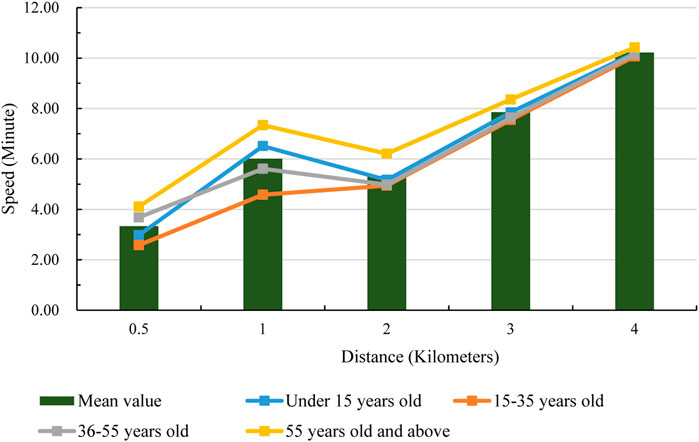
FIGURE 4. Emergency response speed of oil and gas energy resource-based urban shelter planning algorithm based on artificial intelligence resilient city model.
The resource utilization efficiency, environmental impact index, facility completeness, renewable energy utilization and community participation assessment index of urban shelters based on artificial intelligence have all improved compared to traditional shelters. As shown in Figure 5, the highest score of the relevant evaluation criteria was 100. Except for the environmental impact index, the higher the score, the better the evaluation. The lower the environmental impact index, the smaller the impact on the environment. The highest improvement in community participation evaluation index was 56. The improvement in facility integrity was the lowest, with an improvement index of 20 and an average overall index increase of 31. It can be seen that urban shelters based on artificial intelligence have higher resource utilization efficiency, higher community participation and are more environmentally friendly.
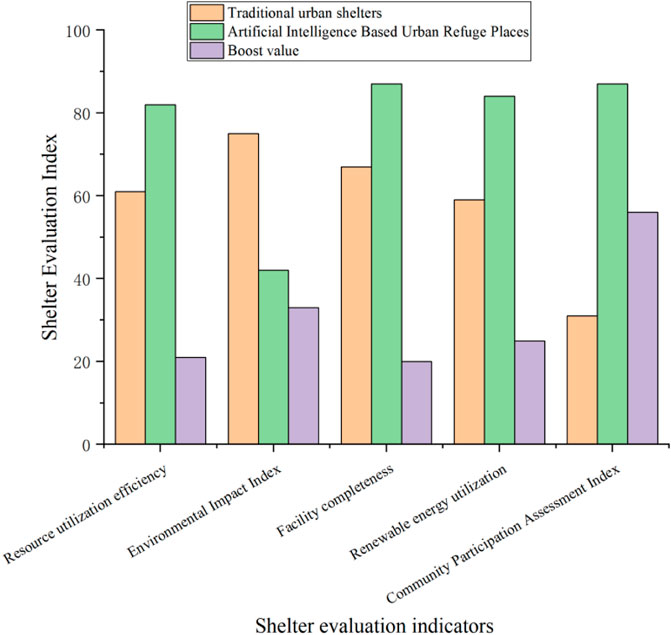
FIGURE 5. Comparison of the indicators of artificial intelligence-based urban shelters and traditional shelters.
7 Conclusion
The planning algorithm for shelter in oil and gas energy resource-based cities based on the artificial intelligence resilient city model is a research direction of great significance in the fields of urban planning and disaster management. This study aims to propose a shelter planning algorithm that comprehensively considers the characteristics of oil and gas energy resource-based cities and disaster risks, using artificial intelligence technology and the concept of resilient cities, to enhance the city’s disaster response capacity and residents’ safety and security. This article first proposed a resilient city model based on artificial intelligence as the theoretical basis for shelter planning. Then, artificial bee colony algorithm was used to optimize the location, capacity planning and facility configuration of the shelter. However, the algorithm still has some limitations, such as the accuracy and reliability of data are prerequisites for the implementation of the algorithm, so it is necessary to establish a comprehensive data collection and monitoring system. The algorithm comprehensively considered factors such as disaster risk, population distribution and transportation convenience to maximize the efficiency and adaptability of shelters. Besides, the implementation of the algorithm also required close cooperation and support from government departments, professional institutions and community residents to ensure the effective implementation of the plan. In summary, the planning algorithm for shelters in oil and gas energy resource-based cities based on the artificial intelligence resilient city model was a significant research work. By comprehensively considering urban characteristics, disaster risks and artificial intelligence technology, scientific decision-making support can be provided for urban planners and disaster managers, improving the resilience and disaster-resistance of cities. Future research can further refine the details of the algorithm and apply and validate it in practical cities to promote innovation and development in urban shelter planning.
Data availability statement
The original contributions presented in the study are included in the article/Supplementary Material, further inquiries can be directed to the corresponding author.
Author contributions
MG: Editing data curation, Supervision. JL: Writing—original draft preparation. All authors contributed to the article and approved the submitted version.
Funding
The study was supported by “the Heilongjiang Province basic research project foundation in university (Grant No. 2020QNW-01)”.
Conflict of interest
The authors declare that the research was conducted in the absence of any commercial or financial relationships that could be construed as a potential conflict of interest.
Publisher’s note
All claims expressed in this article are solely those of the authors and do not necessarily represent those of their affiliated organizations, or those of the publisher, the editors and the reviewers. Any product that may be evaluated in this article, or claim that may be made by its manufacturer, is not guaranteed or endorsed by the publisher.
References
Ahmed, I., Jeon, G., and Piccialli, F. (2022). From artificial intelligence to explainable artificial intelligence in industry 4.0: a survey on what, how, and where. IEEE Trans. Industrial Inf. 18 (8), 5031–5042. doi:10.1109/tii.2022.3146552
Cao, Z., and Qian, L. (2023). Crowding effect of institutional openness based on the big data algorithm on the efficiency of new energy technology innovation. Front. Bioeng. Biotechnol. 11, 1178737. doi:10.3389/fbioe.2023.1178737
Deng, J., Lam, C. S., Wong, M. C., Sin, S. W., and Martins, R. P. (2019). Instantaneous power quality indices detection under frequency deviated environment. IET Sci. Meas. Technol. 13 (8), 1111–1121. doi:10.1049/iet-smt.2018.5123
Guo, Q. (2022). Ecological environmental protection under the concept of integration of green and energy effect. Nat. Environ. Prot. 3 (3), 27–35. doi:10.38007/NEP.2022.030304
Jia, Y., Chuanrong, Z., Jiahong, W., Weidong, L., Rui, L., and Hui, X. (2018). "Integrating multi-agent evacuation simulation and multi-criteria evaluation for spatial allocation of urban emergency shelters. Int. J. Geogr. Inf. Sci. 32 (9), 1884–1910. doi:10.1080/13658816.2018.1463442
Jun-qing, L., and Yun-qi, H. (2020). A hybrid multi-objective artificial bee colony algorithm for flexible task scheduling problems in cloud computing system. Clust. Comput. 23 (4), 2483–2499. doi:10.1007/s10586-019-03022-z
Junian, J., and Azizifar, V. (2018). The evaluation of temporary shelter areas locations using geographic information system and analytic hierarchy process. Civ. Eng. J. 4 (7), 1678–1688. doi:10.28991/cej-03091104
Kann, B. H., Ahmed, H., and Aerts, H. J. (2021). Artificial intelligence for clinical oncology. Cancer Cell 39 (7), 916–927. doi:10.1016/j.ccell.2021.04.002
Kimms, A., and Maiwald, M. (2018). Bi-objective safe and resilient urban evacuation planning. Eur. J. Operational Res. 269 (3), 1122–1136. doi:10.1016/j.ejor.2018.02.050
Meerow, S., Pajouhesh, P., and Thaddeus, R. (2019). Social equity in urban resilience planning. Local Environ. 24 (9), 793–808. doi:10.1080/13549839.2019.1645103
Moreno, C., Allam, Z., Chabaud, D., Gall, C., and Pratlong, F. (2021). Introducing the “15-Minute City”: sustainability, resilience and place identity in future post-pandemic cities. Smart Cities 4 (1), 93–111. doi:10.3390/smartcities4010006
Nouria, R., and Farhad, S. G. (2020). An improved artificial bee colony algorithm based on whale optimization algorithm for data clustering. Multimedia Tools Appl. 79, 32169–32194. 43-44. doi:10.1007/s11042-020-09639-2
Sara, M., and Joshua, P. N. (2019). Urban resilience for whom, what, when, where, and why? Urban Geogr. 40 (3), 309–329. doi:10.1080/02723638.2016.1206395
Shan, P., Lai, X., and Liu, X. (2019). Correlational analytical characterization of energy dissipation-liberation and acoustic emission during coal and rock fracture inducing by underground coal excavation. Energies 12 (12), 2382. doi:10.3390/en12122382
Sircar, A., Yadav, K., Rayavarapu, K., Bist, N., and Oza, H. (2021). Application of machine learning and artificial intelligence in oil and gas industry. Petroleum Res. 6 (4), 379–391. doi:10.1016/j.ptlrs.2021.05.009
Su, H., Chen, W., and Zhang, C. (2023). Evaluating the effectiveness of emergency shelters by applying an age-integrated method. GeoJournal 88 (1), 951–969. doi:10.1007/s10708-022-10669-6
Sun, Z., Anbarasan, M., and Kumar, D. P. (2021). Design of online intelligent English teaching platform based on artificial intelligence techniques. Comput. Intell. 37 (3), 1166–1180. doi:10.1111/coin.12351
Taeihagh, A. (2021). Governance of artificial intelligence. Policy Soc. 40 (2), 137–157. doi:10.1080/14494035.2021.1928377
Wang, T. (2022). Design and implementation of environmental protection publicity based on green energy effect. Nat. Environ. Prot. 3 (3), 54–61. doi:10.38007/NEP.2022.030307
Xu, W., Ma, Y., Zhao, X., Li, Y., Qin, L., and Du, J. (2018). A comparison of scenario-based hybrid bilevel and multi-objective location-allocation models for earthquake emergency shelters: a case study in the central area of Beijing, China. Int. J. Geogr. Inf. Sci. 32 (2), 236–256. doi:10.1080/13658816.2017.1395882
Yin, L., Li, X., Gao, L., Lu, C., and Zhang, Z. (2017). A novel mathematical model and multi-objective method for the low-carbon flexible job shop scheduling problem. Sustain. Comput. Inf. Syst. 13 (3), 15–30. doi:10.1016/j.suscom.2016.11.002
Yu, J., Li, Y., Xin, Z., Chen, Z., Deng, L., Guo, X., et al. (2022). Experimental investigation on the thermal characteristics of ultrathin vapour chamber with in-plane bending. Appl. Therm. Eng. 217 (2022), 119175. doi:10.1016/j.applthermaleng.2022.119175
Zhang, B., Zhu, J., and Su, H. (2023). Toward the third generation artificial intelligence. Sci. China Inf. Sci. 66 (2), 121101–121119. doi:10.1007/s11432-021-3449-x
Keywords: artistic intelligence, resilient city model, oil and gas energy resource-based cities, shelter planning, artificial bee colony
Citation: Liang J and Ge M (2023) Algorithm for planning shelters in oil and gas energy resource-based cities based on artificial intelligence resilient city model. Front. Energy Res. 11:1237180. doi: 10.3389/fenrg.2023.1237180
Received: 09 June 2023; Accepted: 03 August 2023;
Published: 23 August 2023.
Edited by:
Mohamed M. F. Darwish, Aalto University, FinlandReviewed by:
Shailesh Khapre, Indian Institute of Information Technology, Nagpur, IndiaTamanna Singhdeo, Fairleigh Dickinson University, Canada
Copyright © 2023 Liang and Ge. This is an open-access article distributed under the terms of the Creative Commons Attribution License (CC BY). The use, distribution or reproduction in other forums is permitted, provided the original author(s) and the copyright owner(s) are credited and that the original publication in this journal is cited, in accordance with accepted academic practice. No use, distribution or reproduction is permitted which does not comply with these terms.
*Correspondence: Ming Ge, d29zaGlsaWFuZ2ppbmdAMTYzLmNvbQ==
 Jing Liang1
Jing Liang1 Ming Ge
Ming Ge